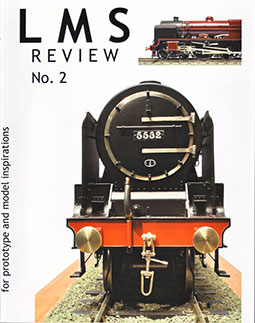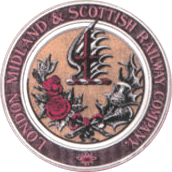LMS Review Issue 2
ISBN 978 1 908763 12 9
Price £18.95
Published December 2014
Contents
|

|
EDITORIAL
I would like to begin by thanking readers who purchased the first edition and to reassure those who seek clarification about the 'model railway' content in future editions. Railways both full size and models have played an important part in my life ever since, as a small boy, I watched the trains that could be seen very clearly across the road from where I lived and, later, usually in the company of others, travelled to see them, Tamworth being a very popular destination. My first attempts in model form, 00, three rail, using what equipment could be obtained began in 1946 and my first article was published in 1962. Beginning with articles, the move into books with the late David Jenkinson and others came a few years later. Many years later, when on a visit to the USA where our daughter and family are living, I went to the Baltimore Railway Museum where I saw a sign that included the statement, 'Knowledge is of no value unless it is shared with others'. I couldn't agree more ..
So how do I think models can be used in this railway journal? Well, as far as I am aware, there are no full-size railways which can any longer show now a goods station was worked, but this can be demonstrated using a model such as Dewsbury Goods which can be found in Model Railway Journal No. 234 and at the HMRS Museum and Study Centre at Butterley where the 7mm scale model is kept. This is, as far as I am aware, the only large model that has been built of a goods station which enables viewers to see and understand how they were worked when our railway system carried vast quantities of coal and merchandise . ..
During the past few months I have visited several model railway exhibitions and similar events where I have been able to talk to modellers about the hobby and several interesting themes have emerged. There is little doubt that the most popular period is from the late 1940s through to the late 1960s, and this suggests that many of us are modelling a period that we saw and remember. This is true for my early years in the hobby, but the more deeply I became involved, the wider my horizons became. I began by modelling the then current early BR period but, influenced by the writing of others, I opted for the 1930s. It was not until I researched the LMS period (1923-47) with the late David Jenkinson that I took things more seriously. ..
After working on several projects, my interest has continued to widen and while I enjoy the BR period when steam was still paramount, I now find the pre-1923 period fascinating. My locomotives and most of my rolling stock are from the early 1900s, but a fresh coat of paint would take some into the 1920s and even later if a few modifications to some of the locomotives were made.. In my case that is not going to happen, but it leads me to point out that if you model a later period, perhaps after nationalisation, it was quite common to find pre-grouping stock still in everyday service. If you study a broad range of pictures of your chosen era, you will see what I mean.
Bob Essery




